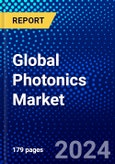The Global Photonics Market is estimated to be USD 649.9 Bn in 2023 and is expected to reach USD 959.79 Bn by 2028 growing at a CAGR of 8.11%.
As the market dynamics impact the supply and demand curves, decision-makers aim to determine the best way to use various financial tools to stem various strategies for speeding the growth and reducing the risks.
Market Dynamics
Market dynamics are forces that impact the prices and behaviors of the Global Photonics Market stakeholders. These forces create pricing signals which result from the changes in the supply and demand curves for a given product or service. Forces of Market Dynamics may be related to macro-economic and micro-economic factors. There are dynamic market forces other than price, demand, and supply. Human emotions can also drive decisions, influence the market, and create price signals.As the market dynamics impact the supply and demand curves, decision-makers aim to determine the best way to use various financial tools to stem various strategies for speeding the growth and reducing the risks.
Market Segmentations
- The Global Photonics Market is segmented based on Product, Application, Industry, and Geography.
- By Product, the market is classified into LED, Lasers, Detectors, Sensors, and Imaging Devices, Optical Communication Systems & Components, and Consumer Electronics & Devices.
- By Application, the market is classified into Displays, Information & communication technology, Photovoltaic, Medical Technology & Life sciences (Biophotonics), Measurement & Automated Vision, Lighting, and Production Technology.
- By Industry, the market is classified into Building & Construction, Media, Broadcasting and Telecommunication, Consumer & Business Automation, Medical, Safety & Defense, and Industrial.
- By Geography, the market is classified into Americas, Europe, Middle-East & Africa and Asia-Pacific.
Company Profiles
The report provides a detailed analysis of the competitors in the market. It covers the financial performance analysis for the publicly listed companies in the market. The report also offers detailed information on the companies' recent development and competitive scenario. Some of the companies covered in this report are Signify, Scott, Shin-Etsu Chemical Company, Nikon, Hoya, Corning, American Elements, Ohara, Asahi Glass, Huawei Technologies, etc.Countries Studied
- America (Argentina, Brazil, Canada, Chile, Colombia, Mexico, Peru, United States, Rest of Americas)
- Europe (Austria, Belgium, Denmark, Finland, France, Germany, Italy, Netherlands, Norway, Poland, Russia, Spain, Sweden, Switzerland, United Kingdom, Rest of Europe)
- Middle-East and Africa (Egypt, Israel, Qatar, Saudi Arabia, South Africa, United Arab Emirates, Rest of MEA)
- Asia-Pacific (Australia, Bangladesh, China, India, Indonesia, Japan, Malaysia, Philippines, Singapore, South Korea, Sri Lanka, Thailand, Taiwan, Rest of Asia-Pacific)
Competitive Quadrant
The report includes Competitive Quadrant, a proprietary tool to analyze and evaluate the position of companies based on their Industry Position score and Market Performance score. The tool uses various factors for categorizing the players into four categories. Some of these factors considered for analysis are financial performance over the last 3 years, growth strategies, innovation score, new product launches, investments, growth in market share, etc.Ansoff Analysis
- The report presents a detailed Ansoff matrix analysis for the Global Photonics Market. Ansoff Matrix, also known as Product/Market Expansion Grid, is a strategic tool used to design strategies for the growth of the company. The matrix can be used to evaluate approaches in four strategies viz. Market Development, Market Penetration, Product Development and Diversification. The matrix is also used for risk analysis to understand the risk involved with each approach.
- The publisher analyses the Global Photonics Market using the Ansoff Matrix to provide the best approaches a company can take to improve its market position.
- Based on the SWOT analysis conducted on the industry and industry players, the publisher has devised suitable strategies for market growth.
Why buy this report?
- The report offers a comprehensive evaluation of the Global Photonics Market. The report includes in-depth qualitative analysis, verifiable data from authentic sources, and projections about market size. The projections are calculated using proven research methodologies.
- The report has been compiled through extensive primary and secondary research. The primary research is done through interviews, surveys, and observation of renowned personnel in the industry.
- The report includes an in-depth market analysis using Porter's 5 forces model and the Ansoff Matrix. In addition, the impact of Covid-19 on the market is also featured in the report.
- The report also includes the regulatory scenario in the industry, which will help you make a well-informed decision. The report discusses major regulatory bodies and major rules and regulations imposed on this sector across various geographies.
- The report also contains the competitive analysis using Positioning Quadrants, the Proprietary competitive positioning tool.
Report Highlights:
- A complete analysis of the market, including parent industry
- Important market dynamics and trends
- Market segmentation
- Historical, current, and projected size of the market based on value and volume
- Market shares and strategies of key players
- Recommendations to companies for strengthening their foothold in the market
Table of Contents
1 Report Description
2 Research Methodology
3 Executive Summary
4 Market Dynamics
5 Market Analysis
6 Global Photonics Market, By Product
7 Global Photonics Market, By Application
8 Global Photonics Market, By Industry
9 Americas' Photonics Market
10 Europe's Photonics Market
11 Middle East and Africa's Photonics Market
12 APAC's Photonics Market
13 Competitive Landscape
14 Company Profiles
15 Appendix
Companies Mentioned
- Signify
- Scott
- Shin-Etsu Chemical Company
- Nikon
- Hoya
- Corning
- American Elements
- Ohara
- Asahi Glass
- Huawei Technologies
- Cisco Systems
- Coherent
- Trumpf Group
- General Electric Company
- Toshiba Medical Systems (Toshiba)
- Hitachi
- Emerson
- Siemens
- LG Display
- Samsung Electronics
- Innolux
- Osram Licht
- Trina Solar
- IPG Photonics




